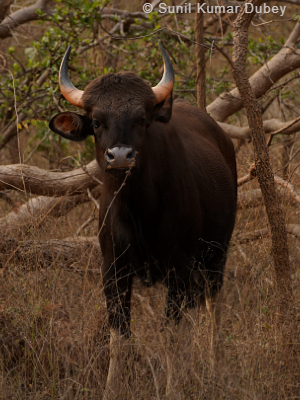
Indian gaur is a large bovine, easily seen at some of the wildlife destinations of Madhya Pradesh. They are motive to the Indian subcontinent and south-east Asia. Due to their look, sometimes first time visitors mistaken their identity as wild buffalo or term them as Bison. In reality, despite of some similarities Indian Gaur have its separate identity. Indian gaur and American Bison are indeed the largest wild bovines but are found at two different continents. Here Gaur size, body weight, height at shoulder is larger than American Bison. At Madhya Pradesh, at present wild buffaloes are not found thus their is no case of any confusion. They can easily be identified during jungle safari drives due to their distinctive features, size and habits. Most of the time they are seen busy in grazing, scattered over a small area, in herd size of 3 -15 members. Mostly they are seen near hilly terrains in cool and calm mood but despite of this, if mother is with calf or bull is standing near by safari trail, we should must maintain a safe distance and never try to approach close to them for sake of photography or any reason as their mood changes quickly and may show very aggressive behavior. Due to their size and power, they can prove dangerous to anyone.
Gaurs are primarily found at eastern and south-eastern forest areas of Madhya Pradesh. Their ideal habitat includes Tropical moist deciduous forest, Tropical dry deciduous forest, Evergreen and semi-evergreen forest, Sal forest. At Madhya Pradesh they are mostly found in Maikal range, Satpura range and some areas of Vindhya range forest. When it come to exact location then we recommend following national parks for Indian gaur safari and photography.
| Places for best viewing | ||
| Kanha National Park | Bandhavgarh | Pench National Park |
| Satpura National Park | ||
Gaurs are mostly seen at undulationg and hilly grasslands. As per their feeding habit, they are mostly seen during monsoon and winter season. During summers, they often change their locations close to some river, backwater or shady forest with good presence of forest. They are primarily diurnal. As most of the jungle safaris are done is daytime thus we can expect their sighting during our morning or afternoon jeep safari drives. At Madhya Pradesh, travel season from October to March is the best time to see them, at above mentioned national parks, at daytime.
Please check below given table to learn some vital details and characteristic features.
| Title | Details |
| Kingdom | Anamalia |
| Phylum | Chordata |
| Sub-phylum | Vertebrata |
| Class | Mammalia |
| Order | Artiodactyla |
| Sub-family | Bovinae |
| Family | Bovidae |
| Genus | Bos |
| Species | Bos gaurus |
| Visible features | Light brownish of calves but on gaining adulthood, they become dark brown. Males are more dark then females. Both male & females have white stokings on all 4 legs. |
| Life Span | 23-27 years |
| Size | Length = 245 - 340 cm, Height = 160-230 cm |
| Weight | 600 to 1000 kg. Males are more body weight than females. |
| Conservation Status | Vulnerable |
| Nature | Females with calf are mostly seen in groups. Male gaur may be seen roaming solitary. |
| Gestation Period | Approx. 09 months |
| Breeding Season | December to June |
| Relationship Status | Females with calf are mostly seen in herd (group) where as male gaur may be seen roaming solitary or sometime, close to herd. They are polygamous. |
| Dietary | Herbivores |
| Local Name | Gaur (in Hindi), Gawa (in Marathi) |